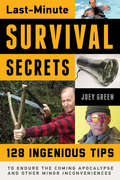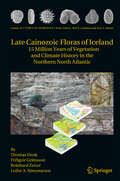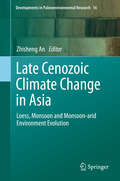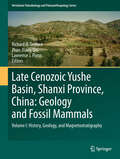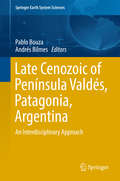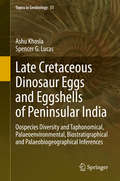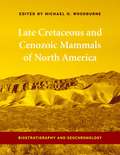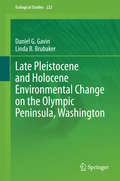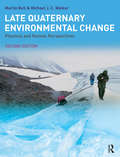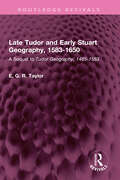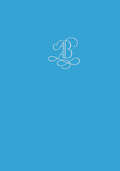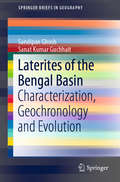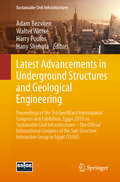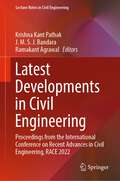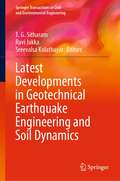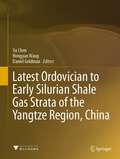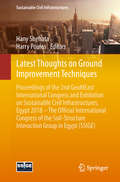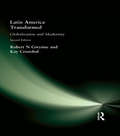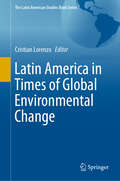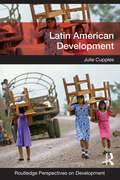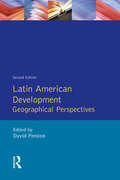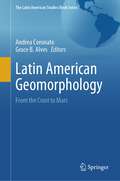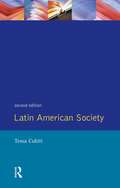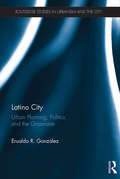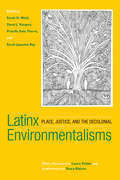- Table View
- List View
Last-Minute Survival Secrets: 128 Ingenious Tips to Endure the Coming Apocalypse and Other Minor Inconveniences
by Joey GreenLast-Minute Survival Secrets contains more than a hundred ingenious survival tips that may sound quirky at first, but really do work. Readers will discover a wide range of handy and unusual secrets to outsmart the unexpected and escape perilous situations using common, household products. Green shows how to start a campfire with potato chips, open a locked suitcase with a ballpoint pen, and prevent heatstroke with a disposable diaper. Readers will learn to build a solar cooker using cardboard and aluminum foil, a flood alarm with aspirin and a clothespin, and a wi-fi antenna with a coffee can. The book is even helpful for life's everyday disasters such as when a thunderstorm knocks out the power, the dog is sprayed by a skunk, or your car breaks down in the middle of nowhere. The book also includes interesting and goofy sidebars related to these survival tactics and fascinating trivia to keep you entertained until FEMA arrives. It's the perfect resource for armchair survivalists, budding MacGyvers, and adventurists on a budget.
Late Cainozoic Floras of Iceland
by Friðgeir Grimsson Leifur A. Símonarson Reinhard Zetter Thomas DenkBeing the only place in the northern North Atlantic yielding late Cainozoic terrestrial sediments rich in plant fossils, Iceland provides a unique archive for vegetation and climate development in this region. This book includes the complete plant fossil record from Iceland spanning the past 15 million years. Eleven sedimentary rock formations containing over 320 plant taxa are described. For each flora, palaeoecology and floristic affinities within the Northern Hemisphere are established. The exceptional fossil record allows a deeper understanding of the role of the "North Atlantic Land Bridge" for intercontinental plant migration and of the Gulf Stream-North Atlantic Current system for regional climatic evolution. 'Iceland sits as a "fossil trap" on one of the most interesting biogeographic exchange routes on the planet - the North Atlantic. The fossil floras of Iceland document both local vegetational response to global climate change, and more importantly, help to document the nature of biotic migration across the North Atlantic in the last 15 million years. In this state-of-the-art volume, the authors place sequential floras in their paleogeographic, paleoclimatic and geologic context, and extract a detailed history of biotic response to the dynamics of physical change.' Bruce H. Tiffney, University of California, Santa Barbara 'This beautifully-illustrated monograph of the macro- and microfloras from the late Cenozoic of Iceland is a worthy successor to Oswald Heer's "Flora fossilis arctica". Its broad scope makes it a must for all scientists interested in climatic change and palaeobiogeography in the North Atlantic region. It will remain a classic for years to come.' David K. Ferguson, University of Vienna
Late Cenozoic Climate Change in Asia
by Zhisheng AnThis book is the first of its kind on environmental change research devoted to monsoon-arid environment evolution history and its mechanism involved. Capturing the most prominent features of Asian climate and environmental changes, it gives a comprehensive review of the Asian Monsoon records providing evidence for spatial and temporal climatic and environmental changes across the Asian continent since the Late Cenozoic. The dynamics underlying these changes are explored based on various bio-geological records and in particular based on the evidence of loess, speleothems as well as on mammal fossils. The Asian monsoon-arid climate system which quantifies the controlling mechanisms of climate change and the way it operates in different time scales is described. Attempts to differentiate between natural change and human-induced effects, which will help guide policies and countermeasures designed to support sustainable development on the Chinese Loess Plateau and the arid west.
Late Cenozoic Yushe Basin, Shanxi Province, China: Volume I:History, Geology, and Magnetostratigraphy
by Lawrence J Flynn Richard H Tedford Zhan-Xiang QiuThe Late Cenozoic Yushe Basin, Shanxi Province, China embodies the bulk of our knowledge on successions of terrestrial vertebrates in the northern part of East Asia. Everything we know about Asian mammals of the last 6 million years has a historical basis in the documentation of the geology of Yushe. This volume introduces the basin in its geological setting, describes the succession of fossiliferous strata, and shows how it is dated. It develops an unsurpassed level of precision for its age control. Geological maps and stratigraphic sections provide the backbone for individual studies to follow on varied fossil groups. The volume explores the history of exploration of the last century in Yushe Basin and places development of paleontology there into the context of the birth of the modern epoch of science in China.
Late Cenozoic of Península Valdés, Patagonia, Argentina: An Interdisciplinary Approach (Springer Earth System Sciences)
by Pablo Bouza Andrés BilmesThis book presents extensive and new information on the Cenozoic marine and continental systems of one of the most important World Heritage sites of Southern South America: The Península Valdés. Using an interdisciplinary approach, that includes geological, biological and archeological perspectives of more than 30 specialists, an integrated description and analysis of the Cenozoic environments of the study region is presented. The volume brings together an update of the geology, climate, geomorphology, soils, biodiversity, archeology and human impact of the Península Valdés. The scope of this book extends to any natural science researcher of the world interested on the Cenozoic history of the Península Valdés.
Late Cretaceous Dinosaur Eggs and Eggshells of Peninsular India: Oospecies Diversity and Taphonomical, Palaeoenvironmental, Biostratigraphical and Palaeobiogeographical Inferences (Topics in Geobiology #51)
by Spencer G. Lucas Ashu KhoslaThis book documents analyses of the Late Cretaceous dinosaur nesting sites of the Lameta Formation at Jabalpur, Districts Dhar and Jhabua, Madhya Pradesh; Districts Kheda and Panchmahal (Gujarat); and the Pisdura, Dongargaon and Pavna sectors in the Chandrapur Districts of Maharashtra, which are exposed in India along an east-west and central axis. In this work, special emphasis has been given to the dinosaur nesting sites of the east-central Narbada River region, including its regional geology. The work was undertaken to provide detailed information concerning dinosaur eggs, eggshell fragments, nests and clutches found in the Lameta Formation of peninsular India. Prior to the present work there had been no detailed review of systematic work on the taxonomy, and of micro- and ultrastructural studies of dinosaur eggs and eggshells from the Lameta Formation. The study documents the field and laboratory investigations that facilitated the reconstruction of the morphotaxonomy, models for the burial pattern of eggs and eggshells, taphonomic implications,and the palaeoenvironmental context and palaeoecological conditions during the Late Cretaceous at the time of the extrusion of the Deccan traps, which may have been partly responsible for the extinction of the dinosaurs. The need to follow a parataxonomic classification for Indian dinosaur eggs and eggshell types is very apparent, and this book addresses this aspect in some detail. The emphasis on the application of parataxonomic schemes is based on the description of new oospecies and their comparison with previously known forms. The present work has led to the recovery of numerous nests, many collapsed eggs and hundreds of dinosaur eggshell fragments from the localities situated near the east, west and central Narbada River regions. It will be of interest to academics and professional palaeontologists, and all students of dinosaurs.
Late Cretaceous and Cenozoic Mammals of North America: Biostratigraphy and Geochronology
by Michael WoodburneThis book places into modern context the information by which North American mammalian paleontologists recognize, divide, calibrate, and discuss intervals of mammalian evolution known as North American Land Mammal Ages. It incorporates new information on the systematic biology of the fossil record and utilizes the many recent advances in geochronologic methods and their results. The book describes the increasingly highly resolved stratigraphy into which all available temporally significant data and applications are integrated. Extensive temporal coverage includes the Lancian part of the Late Cretaceous, and geographical coverage includes information from Mexico, an integral part of the North American fauna, past and present.
Late Pleistocene and Holocene Environmental Change on the Olympic Peninsula, Washington
by Daniel G. Gavin Linda B. BrubakerThis study brings together decades of research on the modern natural environment of Washington's Olympic Peninsula, reviews past research on paleoenvironmental change since the Late Pleistocene, and finally presents paleoecological records of changing forest composition and fire over the last 14,000 years. The focus of this study is on the authors' studies of five pollen records from the Olympic Peninsula. Maps and other data graphics are used extensively. Paleoecology can effectively address some of these challenges we face in understanding the biotic response to climate change and other agents of change in ecosystems. First, species responses to climate change are mediated by changing disturbance regimes. Second, biotic hotspots today suggest a long-term maintenance of diversity in an area, and researchers approach the maintenance of diversity from a wide range and angles (CITE). Mountain regions may maintain biodiversity through significant climate change in 'refugia': locations where components of diversity retreat to and expand from during periods of unfavorable climate (Keppel et al. , 2012). Paleoecological studies can describe the context for which biodiversity persisted through time climate refugia. Third, the paleoecological approach is especially suited for long-lived organisms. For example, a tree species that may typically reach reproductive sizes only after 50 years and remain fertile for 300 years, will experience only 30 to 200 generations since colonizing a location after Holocene warming about 11,000 years ago. Thus, by summarizing community change through multiple generations and natural disturbance events, paleoecological studies can examine the resilience of ecosystems to disturbances in the past, showing how many ecosystems recover quickly while others may not (Willis et al. , 2010).
Late Quaternary Environmental Change: Physical and Human Perspectives
by Martin Bell M.J.C. WalkerLate Quaternary Environmental Change addresses the interaction between human agency and other environmental factors in the landscapes, particularly of the temperate zone.Taking an ecological approach, the authors cover the last 20,000 years during which the climate has shifted from arctic severity to the conditions of the present interglacial environment.
Late Tudor and Early Stuart Geography, 1583-1650: A Sequel to Tudor Geography, 1485-1583 (Routledge Revivals)
by E. G. TaylorFirst published in 1934, Late Tudor and Early Stuart Geography is a critical commentary on a chronologically arranged bibliography of nearly two thousand contemporary printed and manuscript works. Poets, preachers and philosophers, mathematicians, physicians and astrologers, sailors, merchants and company-promoters were contributors to the absorbing medley that comprises the geographical literature of the late Tudor and early Stuart period. For this was the fading twilight of that Golden Age of unspecialized learning when all knowledge lay within one man’s compass. This book will be of interest to historians, economists, sociologists and litterateurs.
Late- and Postglacial Oscillations of Glaciers: Glacial And Periglacial Forms
by H. Schroeder-LanzThis volume represents the proceedings from a colloquium held in West Germany in 1980 on late and postglacial oscillations of glaciers. The main texts are in German (13), English (8) and French (5) but all have abstracts in the three languages and all the figure captions are similarly translated.
Laterites of the Bengal Basin: Characterization, Geochronology and Evolution (SpringerBriefs in Geography)
by Sandipan Ghosh Sanat Kumar GuchhaitThis Brief analyses and discusses the laterites in the Bengal Basin. The book highlights: (1) the definition, identification and classification of ferruginous materials, (2) the mode of laterite formation and its other horizons, (3) processes and theories of lateritisation, (4) determination of laterite ages, (5) recognition of palaeogeomorphic and palaeoclimatic significance and (6) geo-chronology and reconstruction of former lateritized landscapes. The chapters cover the tectono-climatic evolution of north-south laterite profiles of the north-western Bengal Basin on the Rajmahal Basalt Traps, Archean Granite-Gneiss, Gondwana Sandstones, Palaeogene Gravels and Older Palaeo-Deltaic Alluvium. The book uses advanced field-based studies, quantitative analysis and thematic mapping to cover various areas of palaeogeography and regolith geology of the Bengal Basin in connection with laterite genesis, palaeoweathering, tectonic geomorphology, Quaternary geomorphology and pedogeomorphology. It introduces laterites as a potential stratigraphic marker in Indian geology by explaining their palaeogeomorphic and palaeoclimatic significance.This Brief is a comprehensive resource to researchers, students and academicians of geography, geomorphology and geology working on laterites.
Latest Advancements in Underground Structures and Geological Engineering: Proceedings of the 3rd GeoMEast International Congress and Exhibition, Egypt 2019 on Sustainable Civil Infrastructures – The Official International Congress of the Soil-Structure Interaction Group in Egypt (SSIGE) (Sustainable Civil Infrastructures)
by Walter Wittke Hany Shehata Harry Poulos Adam BezvijenThis book includes the best-selected papers on the latest advancements in underground structures and geological engineering.The ongoing population growth is resulting in rapid urbanization, new infrastructure development, and increasing demand for the Earth's natural resources (e.g., water, oil/gas, minerals). This, together with the current climate change and increasing impact of natural hazards, implies that the engineering geology profession is called upon to respond to new challenges. It is recognized that these challenges are particularly relevant in the developing and newly industrialized regions.
Latest Developments in Civil Engineering: Proceedings from the International Conference on Recent Advances in Civil Engineering, RACE 2022 (Lecture Notes in Civil Engineering #352)
by J. M. S. J. Bandara Ramakant Agrawal Krishna Kant PathakThis book comprises select proceedings of the International Conference on Recent Advances in Civil Engineering (RACE 2022). The contents of this book focus on the recent advancements and innovations in the field of civil engineering and various related areas such as design and development of new sustainable and smart building materials, performance analysis and simulation of steel structures, design and performance optimization of concrete structures, structural engineering, geotechnical engineering, water resources engineering and hydraulics, transportation and bridge engineering, building services design, surveying and remote sensing, engineering management and renewable energy. This book serves as a useful reference to researchers and professionals in the field of civil engineering.
Latest Developments in Geotechnical Earthquake Engineering and Soil Dynamics (Springer Transactions in Civil and Environmental Engineering)
by T. G. Sitharam Sreevalsa Kolathayar Ravi JakkaThis volume brings together contributions from world renowned researchers and practitioners in the field of geotechnical engineering. The chapters of this book are based on the keynote and invited lectures delivered at the 7th International Conference on Recent Advances in Geotechnical Earthquake Engineering and Soil Dynamics. The book presents advances in the field of soil dynamics and geotechnical earthquake engineering. A strong emphasis is placed on proving connections between academic research and field practice, with many examples, case studies, best practices, and discussions on performance-based design. This volume will be of interest to research scholars, academicians and industry professionals alike.
Latest Ordovician to Early Silurian Shale Gas Strata of the Yangtze Region, China
by Xu Chen Daniel Goldman Hongyan WangThis book presents the accumulated data and current state of geological knowledge on China’s main shale gas fields. It addresses a broad range of topics, including the geological setting, reference sections and published boreholes, lithostratigraphy, biostratigraphy and chronostratigraphy, sedimentology and sequence stratigraphy of the late Ordovician to early Silurian, spatial and temporal distribution patterns and environmental changes in the black shales of the Wufeng and Lungmachi formations, numerical analysis of the Wufengian and Lungmachian Total Organic Carbon (TOC), late Ordovician to early Silurian bentonites of the Yangtze region, and a graptolite atlas of the Wufeng and Lungmachi formations. Given its scope, the book represents a valuable asset for researchers and petroleum engineers alike.
Latest Thoughts on Ground Improvement Techniques: Proceedings of the 2nd GeoMEast International Congress and Exhibition on Sustainable Civil Infrastructures, Egypt 2018 – The Official International Congress of the Soil-Structure Interaction Group in Egypt (SSIGE) (Sustainable Civil Infrastructures)
by Hany Shehata Harry PoulosThe volume contains research studies that cover a wide range of topics related to ground improvement and subsurface structures. This selection of papers represents the state-of-the-art in the analysis and design of different techniques of the ground improvement and deep mixing techniques. It provides engineers and researchers with an update on the recent development in ground improvement techniques and on the analysis and design of important soil structures problems. The volume is based on the best contributions to the 2nd GeoMEast International Congress and Exhibition on Sustainable Civil Infrastructures, Egypt 2018 – The official international congress of the Soil-Structure Interaction Group in Egypt (SSIGE).
Latin America Transformed: Globalization and Modernity
by Robert N Gwynne Kay CristobalPraise for the first edition:'Accomplishes its task to provide readers with a broad multi-disciplinary view on globalization's many impacts on Latin America ... the organization of the collection is logical and thoughtful, and the structural perspectives offered are convincing and powerful. I recommend it to other Latin American social scientists.' Growth and Change 'An impressive, timely and lively volume, which is especially valuable for teaching purposes.' Journal of Latin American Studies'Authoritatively written by leading scholars in their respective fields.' AreaLatin America Transformed, 2nd Edition explains the region's economic, political, social and cultural transformations, its association with globalization and the search for modernity, and contributes to a greater understanding of how these transformations are affecting the people of Latin America.Using a political economy approach to unravel the concepts of globalization and modernity within Latin America, emphasis is placed on interpreting the macro-level structures that frame the transformations taking place. The book also investigates the dynamics of people's livelihoods as they make sense of, rework and live out these structural transformations. The international team of authors involved with the successful first edition have updated their focus and substantially rewritten their material to examine the challenges facing Latin America in the twenty-first century. Three completely new chapters have also been added. Latin America Transformed, 2nd Edition is now even more useful for undergraduate and postgraduate courses that examine economic, political, social and cultural change in Latin America.
Latin America in Times of Global Environmental Change (The Latin American Studies Book Series)
by Cristian LorenzoThis volume discusses the challenges of Latin America in global environmental geopolitics. Written by leading experts, this book brings together Latin American research on global environmental change. They cover a range of topics such as climate change, water, forest and biodiversity conservation connected with science policies, public opinion, priorities of international funds, and international politics of Latin American countries. The book describes the discrepancy between the international priorities and the regional needs or country interests. It includes several case studies and analyses the cooperation in multilateral negotiations on climate change. It also offers a synthesis of debates around global environmental changes and Latin American politics, which the authors have previously promoted in different academic events in South America, including in Santiago de Chile in Chile, and Buenos Aires and Ushuaia in Argentina.This book assesses the environmental problems from different perspectives, highlights the scientific development in the environmental changes affecting Latin America and offers a new view on geopolitics to help face those issues. Specialist readers in international relations, political sciences, environmental sciences, geography and geopolitics will appreciate this up-to-date examination of Latin America and the global environmental change.
Latin American Development (Routledge Perspectives on Development)
by Julie CupplesLatin America’s diverse political and economic struggles and triumphs have captured the global imagination. The region has been a site of brutal dictators, revolutionary heroes, the Cold War struggle and as a place in which the global debt crisis has had some of its most lasting and devastating impacts. Latin America continues to undergo rapid transformation, demonstrating both inspirational change and frustrating continuities. This text provides a comprehensive introduction to Latin American development in the twenty-first century, emphasizing political, economic, social, cultural and environmental dimensions of development. It considers key challenges facing the region and the diverse ways in which its people are responding, as well as providing analysis of the ways in which such challenges and responses can be theorized. This book also explores the region’s historical trajectory, the implementation and rejection of the neoliberal model and the role played by diverse social movements. Relations of gender, class and race are considered, as well as the ways in which media and popular culture are forging new global imaginaries of the continent. The text also considers the increasing difficulties that Latin America faces in confronting climate change and environmental degradation. This accessible text gives an overarching historical and geographical analysis of the region and critical analysis of recent developments. It is accompanied by a diverse range of critical historical and contemporary case studies from all parts of the continent, providing readers with the conceptual tools required to analyse theories on Latin American development. Each chapter ends with a summary section, discussion topics, suggestions for further reading, websites and media resources. This is an indispensable resource for scholars, students and practitioners.
Latin American Development: Geographical Perspectives
by David A. PrestonProvides an up-to-date analysis of many aspects of Latin America through a series of short essays, written by experienced geographers.
Latin American Geomorphology: From the Crust to Mars (The Latin American Studies Book Series)
by Andrea Coronato Grace B. AlvesThis book presents varied geomorphological topics and planetary studies from different geomorphological regions analysed by young researchers from Latin America, from Costa Rica to southern Argentina, from the mountains to the oceans, and from the Caribbean to the Scotia tectonic plates. The six chapters included in this book originate from presentations made during the “IAG Central and South American Webinar” carried on in March 2021 for the commemoration of the “Geomorphology Week”, promoted by the International Association of Geomorphologists (IAG) and coordinated by the invited book editors. The chapters develop topics related to landforms and geomorphological processes originated by modern tectonics along a transform tectonic plate boundary, by cryo-snowy environments in the drier Central Andes, by fluvial and littoral processes in the Brazilian inland and the Atlantic coast, and by high runoff generated by storm-cells driving into mountainousand wooded terrains. New insights on Mars water features research are also included in the book. Several chapters refer to risk assessment for society or resource management considerations; other chapters refer to present or recent geomorphological processes but others do so to those developed in the Quaternary.
Latin American Society
by Tessa CubittFirst published in 1995. Routledge is an imprint of Taylor & Francis, an informa company.
Latino City: Urban Planning, Politics, and the Grassroots (Routledge Studies in Urbanism and the City)
by Erualdo R. GonzalezAmerican cities are increasingly turning to revitalization strategies that embrace the ideas of new urbanism and the so-called creative class in an attempt to boost economic growth and prosperity to downtown areas. These efforts stir controversy over residential and commercial gentrification of working class, ethnic areas. Spanning forty years, Latino City provides an in-depth case study of the new urbanism, creative class, and transit-oriented models of planning and their implementation in Santa Ana, California, one of the United States’ most Mexican communities. It provides an intimate analysis of how revitalization plans re-imagine and alienate a place, and how community-based participation approaches address the needs and aspirations of lower-income Latino urban areas undergoing revitalization. The book provides a critical introduction to the main theoretical debates and key thinkers related to the new urbanism, transit-oriented, and creative class models of urban revitalization. It is the first book to examine contemporary models of choice for revitalization of US cities from the point of view of a Latina/o-majority central city, and thus initiates new lines of analysis and critique of models for Latino inner city neighborhood and downtown revitalization in the current period of socio-economic and cultural change. Latino City will appeal to students and scholars in urban planning, urban studies, urban history, urban policy, neighborhood and community development, central city development, urban politics, urban sociology, geography, and ethnic/Latino Studies, as well as practitioners, community organizations, and grassroots leaders immersed in these fields.
Latinx Environmentalisms: Place, Justice, and the Decolonial
by Stacy AlaimoThe whiteness of mainstream environmentalism often fails to account for the richness and variety of Latinx environmental thought. Building on insights of environmental justice scholarship as well as critical race and ethnic studies, the editors and contributors to Latinx Environmentalisms map the ways Latinx cultural texts integrate environmental concerns with questions of social and political justice. Original interviews with creative writers, including Cherríe Moraga, Helena María Viramontes, and Héctor Tobar, as well as new essays by noted scholars of Latinx literature and culture, show how Latinx authors and cultural producers express environmental concerns in their work. These chapters, which focus on film, visual art, and literature—and engage in fields such as disability studies, animal studies, and queer studies—emphasize the role of racial capitalism in shaping human relationships to the more-than-human world and reveal a vibrant tradition of Latinx decolonial environmentalism. Latinx Environmentalisms accounts for the ways Latinx cultures are environmental, but often do not assume the mantle of “environmentalism.”
